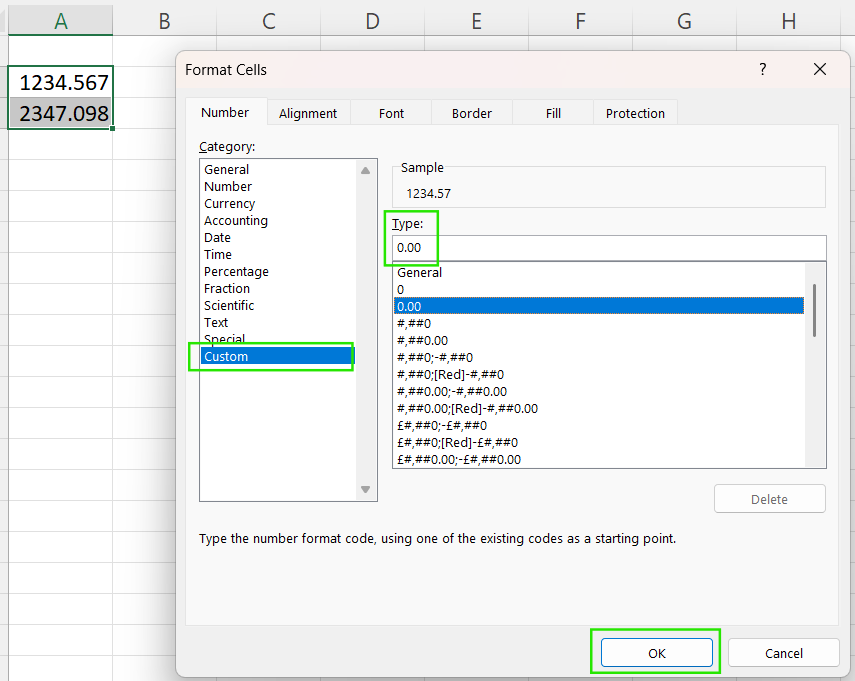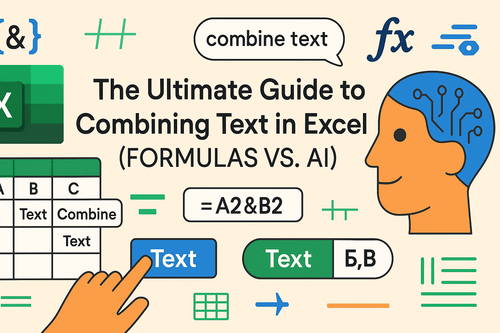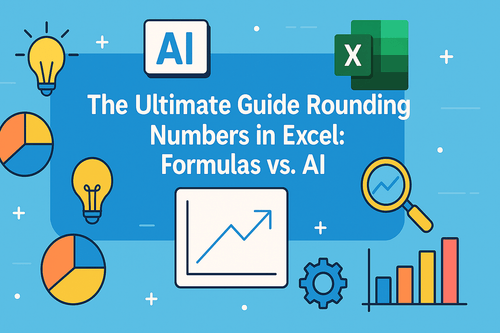Key Takeaways:
- Formatting numbers, dates, and currencies as readable text is essential for professional reports, but Excel's TEXT function requires memorizing complex format codes and formula syntax.
- Excelmatic eliminates the technical barrier by letting you describe the desired format in plain English—no formulas or codes needed.
- For common tasks like formatting dates in text, displaying currency, or standardizing phone numbers, the AI approach is significantly faster and more intuitive than the manual method.
- Adopting AI tools like Excelmatic allows business professionals to create perfectly formatted reports in seconds, saving time and reducing errors.
Formatting numerical data into clean, readable text is crucial for creating professional reports and dashboards. Whether you need to display dates, currency, or percentages within a sentence, Excel provides powerful tools to get the job done.
Traditionally, this task falls to the TEXT() function, a versatile but complex tool that requires memorizing specific format codes. While effective, it can be time-consuming. Today, a new approach using AI tools like Excelmatic allows you to achieve the same results simply by describing what you want in plain language.
In this guide, we'll compare both methods. We'll cover the classic TEXT() function for those who prefer manual control and introduce the faster, more intuitive AI-powered solution for those who want to streamline their workflow.
Method 1: The Traditional Approach with the TEXT() Function
The TEXT() function in Excel is a powerful tool for converting a numeric value into a text string that follows a specified format. Its main purpose is to embed formatted numbers into larger text strings, like custom messages or dynamic chart labels, where standard cell formatting won't work.
How the TEXT() Function Works
The TEXT() function uses two key arguments to transform a numeric input into a formatted text string:
=TEXT(value, format_text)
Where:
value: The number, date, or cell reference you want to format.format_text: A special code, enclosed in double quotes, that defines the desired text style (e.g.,"MM/DD/YY"for a date or"$#,##0.00"for currency).
Common Format Codes and Examples
Mastering TEXT() means learning its format codes. Here are some of the most common ones:
| Format Code | Use Case | Example Input | Formatted Output |
|---|---|---|---|
"0.00" |
Two decimal places (rounds automatically). | 1234.567 |
1234.57 |
"#,##0" |
Adds thousand separators. | 1234567 |
1,234,567 |
"MM/DD/YY" |
US date format. | May 1, 2025 |
05/01/2025 |
"dddd" |
Full weekday name. | 45310 |
Thursday |
"0.0%" |
Converts decimals to percentages. | 0.753 |
75.30% |
"00000" |
Adds leading zeros for fixed-length IDs. | 42 |
0000042 |
"(###) ###-####" |
Standard US phone number format. | 5551234567 |
(555) 123-4567 |
To find more codes, you can open Excel's "Format Cells" dialog (Ctrl+1 or Cmd+1), choose a category, and look at the "Type" field under the "Custom" category.

Method 2: The AI-Powered Alternative with Excelmatic

While the TEXT() function is powerful, remembering all the format codes can be a hassle. AI tools like Excelmatic offer a more intuitive alternative. With Excelmatic, you don't need to write formulas; you simply describe the format you want in plain language.
The process is simple:
- Upload your Excel file to Excelmatic.
- Type a clear instruction describing your desired output.
- Excelmatic handles the complex formatting for you instantly.
Let's see how this modern approach stacks up against the traditional TEXT() function in common scenarios.
Practical Examples: Formulas vs. AI
The true test of any method is how it performs on real-world tasks. Here’s a side-by-side comparison.
Formatting Dates and Times
Excel stores dates as serial numbers, so if you try to combine a date with text directly, you'll get an unreadable number. Both methods solve this, but in different ways.

The Goal: Create a label that says "Report generated on: 05/01/25".
Using
TEXT()Function: You need to concatenate the text with theTEXTfunction and specify the date format.="Report generated on: " & TEXT(TODAY(), "MM/DD/YY")
Using Excelmatic: Simply tell the AI what you want the final text to look like.
Prompt: Create a new column with the text 'Report generated on: ' followed by today's date in MM/DD/YY format.
The Verdict: Excelmatic is more straightforward. You describe the end result without needing to know about concatenation (&) or specific date codes (MM/DD/YY).
Formatting Currency and Percentages
Embedding financial data into text is another common task.
The Goal: Display a price of 2500 as "Final Price: $2,500.00".
Using
TEXT()Function: This requires combining the text label with aTEXTformula using a currency format code.="Final Price: " & TEXT(A2, "$#,##0.00")
Using Excelmatic: Describe the desired output, including the currency symbol and formatting.
Prompt: In a new column, combine the text 'Final Price: ' with the value from column A, formatted as currency with a dollar sign and two decimal places.
The Verdict: Again, Excelmatic wins on simplicity. You don't need to remember if the comma separator is #,##0 or if you need to add .00 for cents.
Adding Leading Zeros and Formatting Phone Numbers
Standardizing IDs or phone numbers for readability is a perfect use case for text formatting.
The Goal: Convert a 10-digit number like 1234567890 into (123) 456-7890.
Using
TEXT()Function: You have to construct the format code with parentheses and hyphens exactly where you want them.=TEXT(A2, "(###) ###-####")
Using Excelmatic: Just describe the standard phone number format.
Prompt: Format the numbers in column A to look like standard US phone numbers, such as (123) 456-7890.
The Verdict: For complex patterns like phone numbers, the TEXT() function requires precise and often tricky format codes. The natural language prompt in Excelmatic is significantly easier and less error-prone.
Advanced Conditional Formatting
What if your text needs to change based on the value?
The Goal: Display "Profit: $250.00" if a value is positive, and "Loss: $250.00" if it's negative.
Using
TEXT()withIFS(): This requires a nested formula combining logic (IFS) and formatting (TEXT).=IFS(A2 > 0, "Profit: " & TEXT(A2, "$0.00"), A2 < 0, "Loss: " & TEXT(ABS(A2), "$0.00"))
Using Excelmatic: You can state the conditions directly in your request.
Prompt: Create a new column. If the value in column A is positive, show 'Profit: ' followed by the value as currency. If it's negative, show 'Loss: ' followed by its absolute value as currency.
The Verdict: The formula-based method becomes quite complex here, involving IFS, TEXT, and ABS. The Excelmatic prompt remains a simple, readable sentence that clearly states the logic.
Troubleshooting and Best Practices
No matter which method you choose, some best practices apply.
- Keep Original Values: Both methods convert numbers to text, which cannot be used in further calculations. It's always best to apply formatting in a new column, keeping your original numeric data intact for analysis.
- Formula Errors (
#NAME?,#VALUE!): When using theTEXT()function, these errors are common.#NAME?usually means you forgot the quotes around your format code.#VALUE!can mean the format code is invalid. - AI Prompt Clarity: With Excelmatic, the key is a clear prompt. If the output isn't what you expected, try rephrasing your request with more specific details. For example, instead of "format the date," say "format the date as 'Weekday, Month Day, Year'."
Conclusion: Which Method Is Right for You?
The TEXT() function remains a fundamental and powerful part of Excel. For users who are comfortable with formulas and need granular control directly within a cell, it's an excellent tool to master.
However, for the vast majority of formatting tasks, an AI-powered tool like Excelmatic offers a faster, more intuitive, and less error-prone solution. By allowing you to use plain language, it removes the need to memorize cryptic format codes and debug complex nested formulas. You can focus on the what (your desired outcome) instead of the how (the specific Excel syntax).
Ready to transform how you work with data? Try Excelmatic for free today and experience the ease of formatting numbers and creating reports using simple language commands.
FAQ
What's the main purpose of formatting numbers as text?
It's used to embed formatted numbers, dates, or times into other text strings (like "Sales for Q1: $1,250,000") where standard cell formatting doesn't apply.
Why is an AI tool sometimes better than the TEXT() function?
An AI tool like Excelmatic eliminates the need to memorize specific format codes and write complex formulas. You can simply describe the desired output in plain English, which is faster and more intuitive.
Can the results of these formatting methods be used in calculations?
No. Both the TEXT() function and text generated by an AI tool produce text strings. These strings cannot be used in mathematical calculations unless you convert them back to numbers (e.g., using the VALUE() function).
How do I fix a #NAME? error with the TEXT() function?
This error almost always means you forgot to enclose the format_text argument in double quotes, for example, writing mm/dd/yyyy instead of "mm/dd/yyyy".
How can I ensure the AI tool understands my request?
Be as specific as possible. Instead of "format currency," say "format as currency with a dollar sign, thousand separators, and no decimal places." Providing an example can also help.






